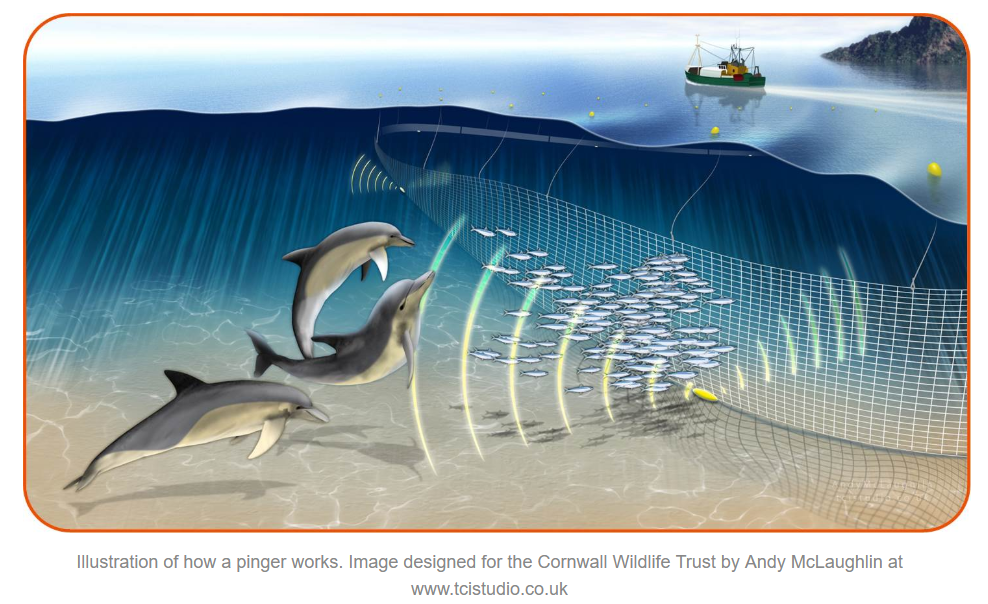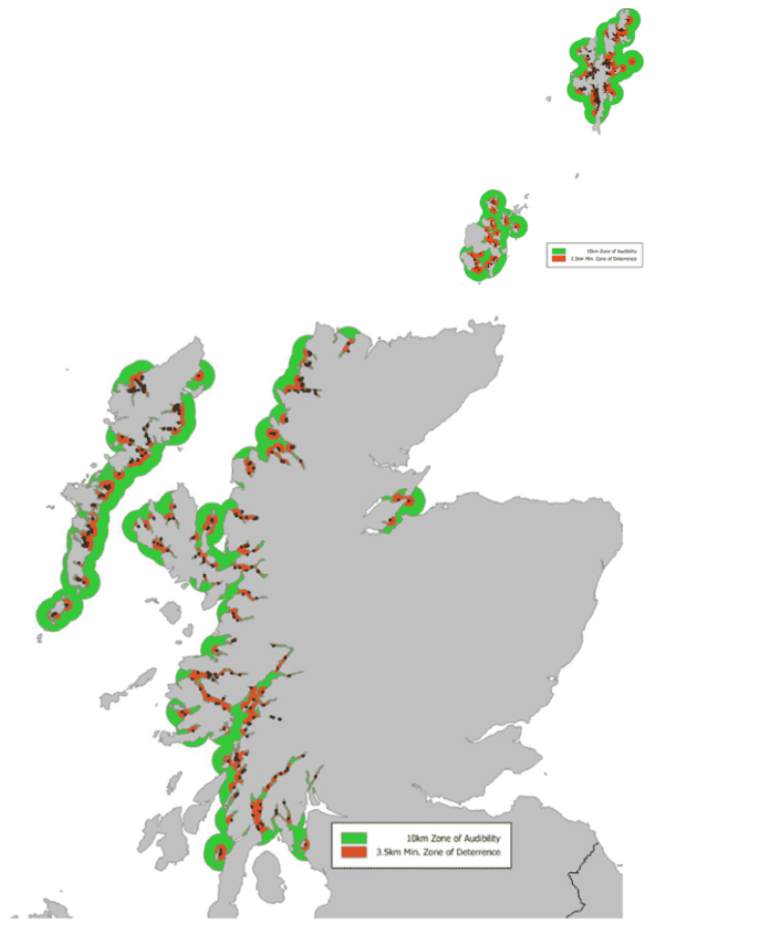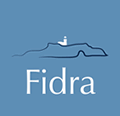Acoustic deterrent devices (ADDs) are intended to keep marine species, such as cetaceans (whales, dolphins and porpoises) and pinnipeds (seals etc.) away from marine structures such as salmon farms. As part of Fidra’s research into the environmental implications of the Scottish salmon farming industry, we wanted to understand the impacts using ADDs can have on marine species. Surprisingly, the use of ADDs is not monitored or measured by any Scottish regulatory bodies. In fact, there is little information about how many ADDs are in use in Scotland, which species they are targeting, and whether or not they achieve their intended purpose of keeping marine species away from structures in the marine environment. This missing information makes it difficult to measure their success or evaluate the implications of their use.
How do Acoustic Deterrent Devices (ADDs) work?

Illustration designed by Andy McLaughlin (www.tcistudio.co.uk) for the Cornwall Wildlife Trust.
ADDs are a form of technology that sends out a high-pitched frequency of sound which is uncomfortable for the intended target to hear. Due to the difference in hearing frequency between ages and species, ADDs are used to prevent unwanted living beings (e.g. in regard to the content of this blog, seals and dolphins) from remaining in a particular area. ADDs have been developed for both the protection and deterrence of marine species. They are used on offshore wind farms to ensure marine species don’t get trapped and confused in between pylons; on and around fishing nets to prevent animals from getting caught; as a non-lethal way of preventing predatory species approaching the farms, damaging the nets in a bid to eat the farmed fish, and resulting in farmed fish escaping through damaged nets.
What does legislation say?
Currently, no specific license is required for farms to be able to implement the use of ADDs. Ultimately, a fish farm’s local authority (the planning department) is responsible for either permitting or rejecting a request, with some input from external audits or impact reporting. The Conservation Regulations 1994 allow the Scottish Natural Heritage (SNH) to object to the planned use of ADDs on a site if they feel that the siting of the farm is likely to disturb cetaceans and the EU Habitats Directive (92/43/EEC) forbids the disturbance of Annex II species, which includes both UK grey and harbour seals and all cetaceans [1]. However, the Scottish Government [2] reports that SNH has rarely objected to an application. With no regulatory process in place, it is worth asking how often applications are put to the organisation for review.
It is clear that there are numerous flaws throughout this process, which puts Scotland’s governmental authorities, industry regulators, researchers and NGOs in an impossible position with regard to understanding how many sites have requested permission to use ADDs and subsequently, how many were granted permission.
How are ADDs used in Scottish salmon farming?
Between 2017-18, Marine Scotland reported that 133 salmon farms were using ADDs as a way to prevent undesirable seal interactions [3]. Whilst it is helpful to understand this detail, the numbers reported via this source do not go far enough to describe the context of this issue. With over 200 active salmon farms in Scotland, is it the case that 100 farms are not using ADDs, or are these farms not being asked by or providing Marine Scotland with accurate information? It should be noted that this data refers to the number of farms using ADDs as opposed to the number of devices that each farm has. Some farms have multiple ADDs in operation, and therefore the total number of ADDs in use would be a more accurate measure of their impacts.
The figure of 133 is already outdated and not an accurate representation of the present situation. With the Scottish Government’s desire to double the sector’s contribution to the Scottish economy by 2030 [4], it is imperative to measure every element of expansion closely, including the number of ADDs in use, to ensure it does not negatively impact on Scotland’s unique ecosystems. Due to the fact that there is no legal obligation for salmon farms to register for a license to use ADDs, there is little accurate data about either their use or the wider impacts in regard to the breeding, feeding and migration behaviours of marine species. This makes it difficult to understand the true context and genuine landscape that exists.
What does the science say?
Researchers have spent the last decade trying to understand the wider impacts of acoustic deterrent devices in Scottish waters. A study of the potential acoustic impacts around the Scottish coast applied the estimated range of effects from ADDs to all Scottish Environment Protection Agency (SEPA) licensed fish farms in Scotland. From this, Researchers were able to predict “the theoretical marine area of ‘deterrence'”, if all sites were using ADDS, to be around 3,500 km2, and the audibility to harbour porpoises to reach as far as 12,600 km2, as shown in Figure 2 [5].
Additional research on the west coast of Scotland found the use of ADDs to have become “a chronic and widespread source of…noise pollution” [6]. Whilst ADD use is often intended to prevent seal depredation, the same study found no conclusive evidence that it was effective and concluded that further research is required to evaluate the success rate of ADDs. It concluded that “there is a clear need to improve the reporting of ADD usage” by highlighting the number in operation, the type of device and the pattern of use. The failure to report this information, it suggests, is fundamentally ignoring requirements stipulated in the Marine Strategy Framework Directive (MSFD), by excluding vital information regarding human generated noise pollution, as well as the impacts that these devices have on marine wildlife [6].

Figure 2: Estimated range of effects from ADDs to all licensed fish farms in Scotland shown as 10km Zone of Audibility (green) and 3.5km Zone of Deterrence (red) [5].
Why should we be concerned about the use of ADDs?
Cetaceans are in constant communication calling across bays as their eyesight in water is poor, and they will swim directly towards family members as though they have a perfect map which is entirely acoustically derived [7]. The acoustic environment of our seas is filled with acoustic pollution which considerably compromises a species’ ability to communicate, locate food and understand their location as they were once able to, prior to the increase in anthropogenic noise pollution. Scientific research suggests ADDs are adding to the acoustic pollution and therefore affecting the health and wellbeing of our marine species[2]. With no enforceable system in place requiring ADDs to be formally registered and accounted for, it is impossible to understand the impacts that these devices are having. Data needs to be recorded and monitored on their number, location and use in Scotland.
The devices used by most salmon farms in Scotland are primarily targeting species like the harbour porpoise and common seal from getting too close to the farm structures and to protect species from entanglement. Regardless, they also make areas that they are sited in, such as harbours, estuaries and shorelines, and where porpoises and seals would give birth to their young, uncomfortable to be in. So, with appropriate monitored, infrequent and regulated use, salmon farms may be able to keep their sites safe, without impacting on the natural behaviours of Scotland’s marine mammals.
Are there alternative solutions?
ADDs can confuse and deafen some species, especially those that rely on echolocation to communicate and hunt. While it can be argued that this is better than shooting predators that come close to farms on a regular basis, it is obviously not an ideal solution. The Scottish Salmon Producers Organisation (SSPO) detail the Code of Good Practice in their Statement on Seals [8] highlighting both ‘seal blinds’, a fine mesh that make it hard for the seals to see the salmon, and high tension outer nets which make it hard for seals to push against and reach the salmon. Additional deterrent methods include electrified netting, which gives out a low voltage, capture and relocation, as well as visual and smell-based deterrents [9]. A visual deterrent in the form of a replica killer whale was recently deployed in Scotland [10]. Due to the difficulty of measuring the success rate of preventative measures, and a lack of research on their effectiveness, it is hard to compare methods and determine which is the best deterrent.
Ultimately, it must be acknowledged that salmon farming is one area where humans and nature will come into opposition. Where a farm holds tonnes of salmon in one place, both cetaceans and pinnipeds will always be attracted – especially when it overlaps with what is already their feeding and breeding ground. Given that the Scottish salmon industry is operating in the marine ecosystems that are the natural habitat of these species, it must strive to reduce its impact on them as much as possible. A significant step towards this would be comprehensive and accurate reporting of ADD use and deployment, enabling effective monitoring and regulation by the relevant bodies. With the uncertainty around ADDs at present however, the most effective action would be investment in installing, assessing and developing alternative solutions.
[1] https://ec.europa.eu/environment/nature/legislation/habitatsdirective/index_en.htm
[2] https://www.gov.scot/publications/evaluating-assessing-relative-effectiveness-acoustic-deterrent-devices-non-lethal-measures/pages/3/
[3] https://www.gov.scot/publications/foi-18-03069/
[4] https://aquaculture.scot/wp-content/uploads/2017/11/Aquaculture_Growth_2030.pdf
[5] Coram, A. J. et al (2014). Evaluating and Assessing the Relative Effectiveness of Acoustic Deterrent Devices and other Non-Lethal Measures on Marine Mammals. Scottish Government. 145pp. https://www.gov.scot/publications/evaluating-assessing-relative-effectiveness-acoustic-deterrent-devices-non-lethal-measures/pages/11/
[6] Findlay, C. et al (2018). Mapping widespread and increasing underwater noise pollution from acoustic deterrent devices. Marine Pollution Bulletin, 135, 1042-1050. https://doi.org/10.1016/j.marpolbul.2018.08.042,
[7] https://www.theguardian.com/science/audio/2019/aug/09/oceans-of-noise-episode-one-science-weekly-podcast
[8] http://scottishsalmon.co.uk/sspo-statement-seals/
[9] https://assets.publishing.service.gov.uk/government/uploads/system/uploads/attachment_data/file/753773/Report_-_Assessing_non-lethal_seal_deterrent_options_literature_and_data_review.pdf
[10] https://www.fishfarmingexpert.com/article/shock-and-orca-mowi-uses-fake-whale-to-scare-seals/
Tags: acoustic, acoustic deterrent device, ADD, cetaceans, conservation, dolphin, harbour, noise, pollution, porpoise, salmon, salmon farming, Scotland, Scottish salmon farming, seals

